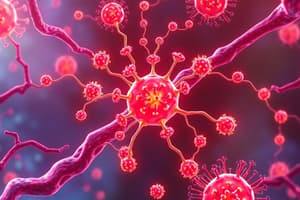Podcast
Questions and Answers
Describe the mechanism by which the complement system distinguishes between self and non-self cells, preventing the destruction of host cells.
Describe the mechanism by which the complement system distinguishes between self and non-self cells, preventing the destruction of host cells.
Complement proteins, particularly C3b, bind to microbial cell surfaces via their reactive thioester bonds, targeting these cells for destruction. However, host cells express regulatory proteins like CD59, which inhibit the formation of the membrane attack complex (MAC) by blocking the recruitment of C9. This prevents the formation of pores in the host cell membrane and protects them from complement-mediated lysis.
Explain how the complement system contributes to both opsonization and the activation of the inflammatory response.
Explain how the complement system contributes to both opsonization and the activation of the inflammatory response.
The complement system contributes to opsonization by attaching C3b and C4b to bacterial surfaces. These complement components act as ligands for complement receptors on phagocytes, enhancing the recognition and engulfment of the microbes. In addition, complement activation produces anaphylatoxins like C5a, which act as pro-inflammatory mediators. These mediators attract immune cells like leukocytes and neutrophils to the site of infection, amplifying the inflammatory response.
Describe the specific steps involved in the formation of the membrane attack complex (MAC) and explain how this structure contributes to bacterial cell death.
Describe the specific steps involved in the formation of the membrane attack complex (MAC) and explain how this structure contributes to bacterial cell death.
The MAC is assembled by the sequential recruitment of complement components C5b, C6, C7, C8, and multiple C9 molecules. C5b initiates the assembly, followed by C6 and C7 binding to the membrane. C8 inserts into the membrane, and finally, C9 molecules polymerize to form a transmembrane pore. This pore disrupts the bacterial membrane, allowing the entry of antimicrobial enzymes and leading to cytosol leakage, bacterial lysis, and cell wall instability.
Explain why patients with terminal complement deficiency are more susceptible to recurrent infections.
Explain why patients with terminal complement deficiency are more susceptible to recurrent infections.
Compare and contrast the roles of C3a and C5a in the complement system.
Compare and contrast the roles of C3a and C5a in the complement system.
Describe the fundamental difference in the initiation mechanisms of the classical and lectin pathways of complement activation, highlighting the key molecules involved in each pathway.
Describe the fundamental difference in the initiation mechanisms of the classical and lectin pathways of complement activation, highlighting the key molecules involved in each pathway.
Explain the role of C3 convertase in the complement system, including its formation and the two distinct forms observed across different pathways.
Explain the role of C3 convertase in the complement system, including its formation and the two distinct forms observed across different pathways.
Detail the mechanism by which the alternative pathway of complement activation is initiated, emphasizing the role of C3(H2O) and Factor B.
Detail the mechanism by which the alternative pathway of complement activation is initiated, emphasizing the role of C3(H2O) and Factor B.
Compare and contrast the functions of opsonization and lysis in the complement system, highlighting the specific complement components involved in each process.
Compare and contrast the functions of opsonization and lysis in the complement system, highlighting the specific complement components involved in each process.
Describe the structure of the C1 complex in the classical pathway, explaining the roles of its components (C1q, C1r, and C1s) in complement activation.
Describe the structure of the C1 complex in the classical pathway, explaining the roles of its components (C1q, C1r, and C1s) in complement activation.
Explain the mechanism of action of the membrane attack complex (MAC), detailing its formation and the critical role of each component involved.
Explain the mechanism of action of the membrane attack complex (MAC), detailing its formation and the critical role of each component involved.
Explain how the alternative pathway functions as an amplification loop, highlighting the role of C3b and the conversion of C3 convertase into C5 convertase.
Explain how the alternative pathway functions as an amplification loop, highlighting the role of C3b and the conversion of C3 convertase into C5 convertase.
Discuss the significance of the complement system`s role in innate immunity, outlining its primary functions and how it contributes to the overall immune response.
Discuss the significance of the complement system`s role in innate immunity, outlining its primary functions and how it contributes to the overall immune response.
Flashcards
C3 convertase
C3 convertase
A complex (C4b2a) that cleaves C3 into C3a and C3b in the complement system.
C5 convertase
C5 convertase
A complex (C4b2aC3b) formed by adding C3b to C3 convertase, cleaves C5 into C5a and C5b.
C5a
C5a
A powerful anaphylatoxin that recruits and activates immune cells, enhancing the inflammatory response.
MAC assembly
MAC assembly
Signup and view all the flashcards
Complement regulation
Complement regulation
Signup and view all the flashcards
Complement System
Complement System
Signup and view all the flashcards
Classical Pathway
Classical Pathway
Signup and view all the flashcards
Lectin Pathway
Lectin Pathway
Signup and view all the flashcards
Alternative Pathway
Alternative Pathway
Signup and view all the flashcards
Opsonization
Opsonization
Signup and view all the flashcards
Membrane Attack Complex (MAC)
Membrane Attack Complex (MAC)
Signup and view all the flashcards
Study Notes
Complement System Overview
- Part of the innate immune system, found in blood plasma, produced in the liver.
- Three key roles: killing (lysis) foreign cells, tagging foreign material (opsonization), and inducing pro-inflammatory signaling and chemoattraction.
- Three pathways converge to create C3 convertase and membrane attack complex (MAC) formation.
Complement Pathways
Classical Pathway
- Initiated by antibodies binding to antigens.
- C1 complex (C1q, C1r, C1s) is activated.
- C1q binds the Fc region of two or more antibodies.
- This activates C1r which cleaves C1s.
- C1s cleaves C4 to C4a and C4b, and C2 to C2a and C2b.
- C4b covalently binds to the target, then binds C2a.
- C4bC2a forms classical C3 convertase.
- Can also bind directly to microbial surfaces (e.g., lipoteichoic acids).
Lectin Pathway
- Initiated by mannose-binding lectin (MBL).
- MBL binds to carbohydrates, specifically mannose, on microbial surfaces.
- MBL-associated serine proteases (MASPs) cleave C4 and C2, forming C4bC2a, the C3 convertase.
Alternate Pathway
- Does not require antibodies or microbes.
- C3 hydrolyzes to C3(H2O).
- C3(H2O) binds Factor B, which is cleaved by Factor D.
- This forms C3(H2O)Bb (initial C3 convertase).
- Factors B and D further initiate an amplification loop of C3 convertase (C3bBb).
- C3b, with high reactivity, binds to microbial surfaces covalently.
Terminal Complement Pathway
- C5 convertase formation from any of the above pathways is required.
- Alternative Pathway: C3bBb binds C3b to form C3bBbC3b (C5 convertase).
- Lectin/Classical Pathway: C4b2a binds C3b to form C4b2aC3b (C5 convertase).
- C5 convertase cleaves C5 into C5a and C5b.
- C5a is an anaphylatoxin, recruiting and activating immune cells.
- C5b initiates MAC (membrane attack complex) formation.
- C6, C7, C8, and C9 proteins assemble to form a pore in the microbial membrane.
- This leads to bacterial lysis and death.
Complement Function
- Opsonization: C3b and C4b act as opsonins, tagging microbes for the immune system.
- Inflammation: Cleaved "a" products (e.g., C3a, C5a) attract and activate leukocytes.
- Lysis: The MAC creates pores, leading to microbial death.
Complement Regulation
- The complement system is tightly regulated to avoid damage to host cells.
- Regulatory proteins on host cells, like CD59, prevent MAC formation.
- Deficiencies in complement proteins result in increased susceptibility to infections.
Studying That Suits You
Use AI to generate personalized quizzes and flashcards to suit your learning preferences.
![Lecture 04: Complement System Overview and Pathways [SEQ 2]](https://assets.quizgecko.com/cdn-cgi/image/width=800,height=300,fit=crop,quality=75,format=webp/quiz/e82a4175420b22396931051deb54c316.jpg)


